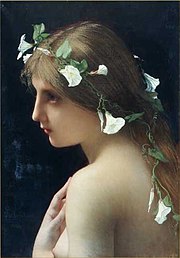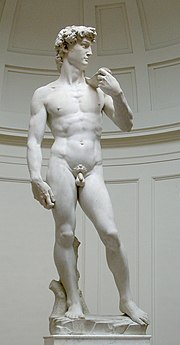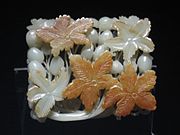
Beauty is a characteristic of a person, place, object, or idea that provides a perceptual experience of pleasure, meaning, or satisfaction. Beauty is studied as part of aesthetics, sociology, social psychology, and culture. As a cultural creation, beauty has been extremely commercialized. An "ideal beauty" is an entity which is admired, or possesses features widely attributed to beauty in a particular culture.
The experience of "beauty" often involves the interpretation of some entity as being in balance and harmony with nature, which may lead to feelings of attraction and emotional well-being. Because this is a subjective experience, it is often said that "beauty is in the eye of the beholder."[1] In its most profound sense, beauty may engender a salient experience of positive reflection about the meaning of one's own existence. A subject of beauty is anything that resonates with personal meaning.
The classical Greek adjective beautiful was καλλός. The Koine Greek word for beautiful was "ὡραῖος",[2] an adjective etymologically coming from the word "ὥρα" meaning hour. In Koine Greek, beauty was thus associated with "being of one's hour". A ripe fruit (of its time) was considered beautiful, whereas a young woman trying to appear older or an older woman trying to appear younger would not be considered beautiful. ὡραῖος in Attic Greek had many meanings, including youthful and ripe old age.[3]
History of beauty
There is evidence that a preference for beautiful faces emerges early in child development, and that the standards of attractiveness are similar across different genders and cultures. [4] Symmetry is also important because it suggests the absence of genetic or acquired defects. Although style and fashion vary widely, cross-cultural research has found a variety of commonalities in people's perception of beauty. Large eyes and a clear complexion, for example, are considered beautiful in both men and women in all cultures. Neonatal features are inherently attractive and youthfulness in general is associated with beauty.
The earliest Western theory of beauty can be found in the works of early Greek philosophers from the pre-Socratic period, such as Pythagoras. The Pythagorean school saw a strong connection between mathematics and beauty. In particular, they noted that objects proportioned according to the golden ratio seemed more attractive. Ancient Greek architecture is based on this view of symmetry and proportion. Modern research also suggests that people whose facial features are symmetric and proportioned according to the golden ratio are considered more attractive than those whose faces are not.

Classical philosophy and sculptures of men and women produced according to these philosophers' tenets of ideal human beauty were rediscovered in Renaissance (Rebirth) Europe, leading to a re-adoption of what became known as a "classical ideal". In terms of female human beauty, a woman whose appearance conforms to these tenets is still called a "classical beauty" or said to possess a "classical beauty", whilst the foundations laid by Greek and Roman artists have also supplied the standard for male beauty in western civilization. The ideal Roman was defined as tall, muscular, long-legged, with a full head of thick hair, a high and wide forehead – a sign of intelligence – wide-set eyes, a strong browline, a strong perfect nose and profile, a smaller mouth, and a strong jaw line. This combination of factors would, as it does today, produce an impressive "grand" look of handsome masculinity.
Beauty ideals may contribute to racial oppression. For example, a prevailing idea in American culture has been that black features are less attractive or desirable than white features. The idea that blackness was ugly was highly damaging to the psyche of African Americans, manifesting itself as internalized racism.[5] The black is beautiful cultural movement sought to dispel this notion.[6] Conversely, beauty ideals may also promote racial unity. Mixed race children are often perceived to be more attractive than their parents because their genetic diversity protects them from the inherited errors of their individual parents. [7]
Human beauty

The characterization of a person as “beautiful”, whether on an individual basis or by community consensus, is often based on some combination of Inner Beauty, which includes psychological factors such as personality, intelligence, grace, congeniality, charm, integrity, congruity and elegance, and Outer Beauty, which includes physical factors, such as health, youthfulness, sexiness, symmetry, averageness, and complexion.
A common way to measure outer beauty, as based on community consensus, or general opinion, is to stage a beauty pageant, such as Miss Universe (so we're told what beauty is?). Inner beauty, however, is more difficult to quantify, though beauty pageants often claim to take this into consideration as well.
A strong indicator of physical beauty is "averageness", or "koinophilia". When images of human faces are averaged together to form a composite image, they become progressively closer to the "ideal" image and are perceived as more attractive. This was first noticed in 1883, when Francis Galton, cousin of Charles Darwin, overlaid photographic composite images of the faces of vegetarians and criminals to see if there was a typical facial appearance for each. When doing this, he noticed that the composite images were more attractive compared to any of the individual images. (haha)Researchers have replicated the result under more controlled conditions and found that the computer generated, mathematical average of a series of faces is rated more favorably than individual faces.[8] Evolutionarily it makes logical sense that sexual creatures should be attracted to mates who possess predominantly common or average features.[9]

Another feature of beautiful women that has been explored by researchers is a waist-to-hip ratio of approximately 0.70 for women. The concept of waist-to-hip ratio (WHR) was developed by psychologist Devendra Singh of the University of Texas at Austin. Physiologists have shown that this ratio accurately indicates most women's fertility. Traditionally, in premodern ages when food was more scarce, overweight people were judged more attractive than slender. In modern times, different standards of beauty are becoming more common. Studies have shown that men find darker tanned women more attractive than lighter skinned women, a relatively recent development.[10]Beauty is not solely limited to the female gender. .More often defined as 'bishōnen,' the concept of beauty in men has been particularly established throughout history in East Asia, and most notably, in Japan. This is distinct from the idea of being metrosexual, which focuses mainly on the behavior of men in traditionally feminine ways. Bishōnen refers to males with distinctly feminine features, physical characteristics establishing the standard of beauty in Japan and typically exhibited in their pop culture idols. The origin of such a preference is uncertain but it clearly exists even today.
Inner beauty
Inner beauty is a concept used to describe the positive aspects of something that is not physically observable.
While most species use physical traits and pheromones to attract mates, some humans claim to rely on the inner beauty of their choices. Qualities including kindness, sensitivity, tenderness or compassion, creativity and intelligence have been said to be desirable since antiquity.
Effects on society
Beauty presents a standard of comparison, and it can cause resentment and dissatisfaction when not achieved. People who do not fit the "beauty ideal" may be ostracized within theircommunities. The television sitcom Ugly Betty portrays the life of a girl faced with hardships due to society's unwelcoming attitudes toward those they deem unattractive. However, a person may also be targeted for harassment because of their beauty. In Malèna, a strikingly beautiful Italian woman is forced into poverty by the women of the community who refuse to give her work in fear that she may "woo" their husbands.
Researchers have found that good looking students get higher grades from their teachers than students with an ordinary appearance.[citation needed] Furthermore, attractive patients receive more personalized care from their doctors.[citation needed] Studies have even shown that handsome criminals receive lighter sentences than less attractive convicts.[citation needed] How much money a person earns may also be influenced by physical beauty. One study found that people low in physical attractiveness earn 5 to 10 percent less than ordinary looking people, who in turn earn 3 to 8 percent less than those who are considered good looking.[11] Discrimination against others based on their appearance is known as lookism.[citation needed]
St. Augustine said of beauty "Beauty is indeed a good gift of God; but that the good may not think it a great good, God dispenses it even to the wicked."[12]



